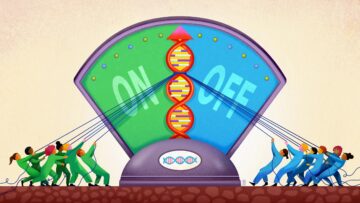Philip Ball in Quanta:
 Initially, it was suspected that gene regulation was a simple matter of one gene product acting as an on/off switch for another gene, in digital fashion. In the 1960s, the French biologists François Jacob and Jacques Monod first elucidated a gene regulatory process in mechanistic detail: In Escherichia coli bacteria, when a repressor protein binds to a certain segment of DNA, it blocks the transcription and translation of an adjacent suite of genes that encode enzymes for digesting the sugar lactose. This regulatory circuit, which Monod and Jacob dubbed the lac operon, has a neat, transparent logic.
Initially, it was suspected that gene regulation was a simple matter of one gene product acting as an on/off switch for another gene, in digital fashion. In the 1960s, the French biologists François Jacob and Jacques Monod first elucidated a gene regulatory process in mechanistic detail: In Escherichia coli bacteria, when a repressor protein binds to a certain segment of DNA, it blocks the transcription and translation of an adjacent suite of genes that encode enzymes for digesting the sugar lactose. This regulatory circuit, which Monod and Jacob dubbed the lac operon, has a neat, transparent logic.
But gene regulation in complex metazoans — animals like humans, with complex eukaryotic cells — doesn’t generally seem to work this way. Instead, it involves a gang of molecules, including proteins, RNAs and pieces of DNA from throughout a chromosome, that somehow collaborate to control the expression of a gene.
More here.
